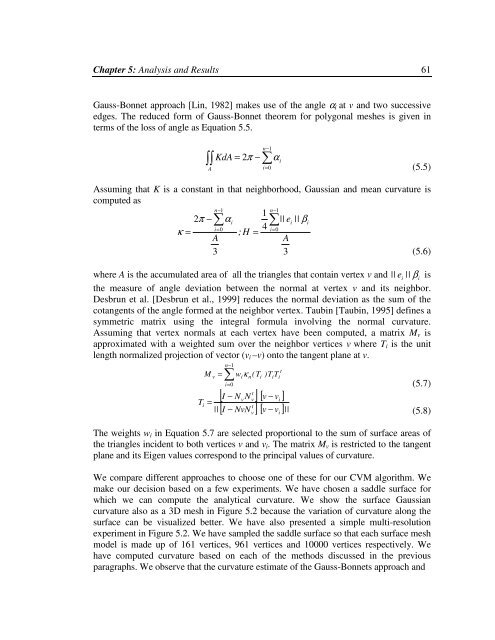To the Graduate Council: I am submitting herewith a thesis written by ...
To the Graduate Council: I am submitting herewith a thesis written by ...
To the Graduate Council: I am submitting herewith a thesis written by ...
Create successful ePaper yourself
Turn your PDF publications into a flip-book with our unique Google optimized e-Paper software.
Chapter 5: Analysis and Results 61Gauss-Bonnet approach [Lin, 1982] makes use of <strong>the</strong> angle α i at v and two successiveedges. The reduced form of Gauss-Bonnet <strong>the</strong>orem for polygonal meshes is given interms of <strong>the</strong> loss of angle as Equation 5.5. − KdA = π −i=An 12 α0i(5.5)Assuming that K is a constant in that neighborhood, Gaussian and mean curvature iscomputed asn−1n−112π−αi||ei|| βii= 0 4 i=0κ = ;H =AA33(5.6)where A is <strong>the</strong> accumulated area of all <strong>the</strong> triangles that contain vertex v and || e || iβiis<strong>the</strong> measure of angle deviation between <strong>the</strong> normal at vertex v and its neighbor.Desbrun et al. [Desbrun et al., 1999] reduces <strong>the</strong> normal deviation as <strong>the</strong> sum of <strong>the</strong>cotangents of <strong>the</strong> angle formed at <strong>the</strong> neighbor vertex. Taubin [Taubin, 1995] defines asymmetric matrix using <strong>the</strong> integral formula involving <strong>the</strong> normal curvature.Assuming that vertex normals at each vertex have been computed, a matrix M v isapproximated with a weighted sum over <strong>the</strong> neighbor vertices v where T i is <strong>the</strong> unitlength normalized projection of vector (v i –v) onto <strong>the</strong> tangent plane at v.n 1= − M v wiκn(Ti)TiTii=0Ti=||t[ I − NvNv] [ v − vi]t[ I − NvN ] [ v − v ]||vit(5.7)(5.8)The weights w i in Equation 5.7 are selected proportional to <strong>the</strong> sum of surface areas of<strong>the</strong> triangles incident to both vertices v and v i . The matrix M v is restricted to <strong>the</strong> tangentplane and its Eigen values correspond to <strong>the</strong> principal values of curvature.We compare different approaches to choose one of <strong>the</strong>se for our CVM algorithm. Wemake our decision based on a few experiments. We have chosen a saddle surface forwhich we can compute <strong>the</strong> analytical curvature. We show <strong>the</strong> surface Gaussiancurvature also as a 3D mesh in Figure 5.2 because <strong>the</strong> variation of curvature along <strong>the</strong>surface can be visualized better. We have also presented a simple multi-resolutionexperiment in Figure 5.2. We have s<strong>am</strong>pled <strong>the</strong> saddle surface so that each surface meshmodel is made up of 161 vertices, 961 vertices and 10000 vertices respectively. Wehave computed curvature based on each of <strong>the</strong> methods discussed in <strong>the</strong> previousparagraphs. We observe that <strong>the</strong> curvature estimate of <strong>the</strong> Gauss-Bonnets approach and
















